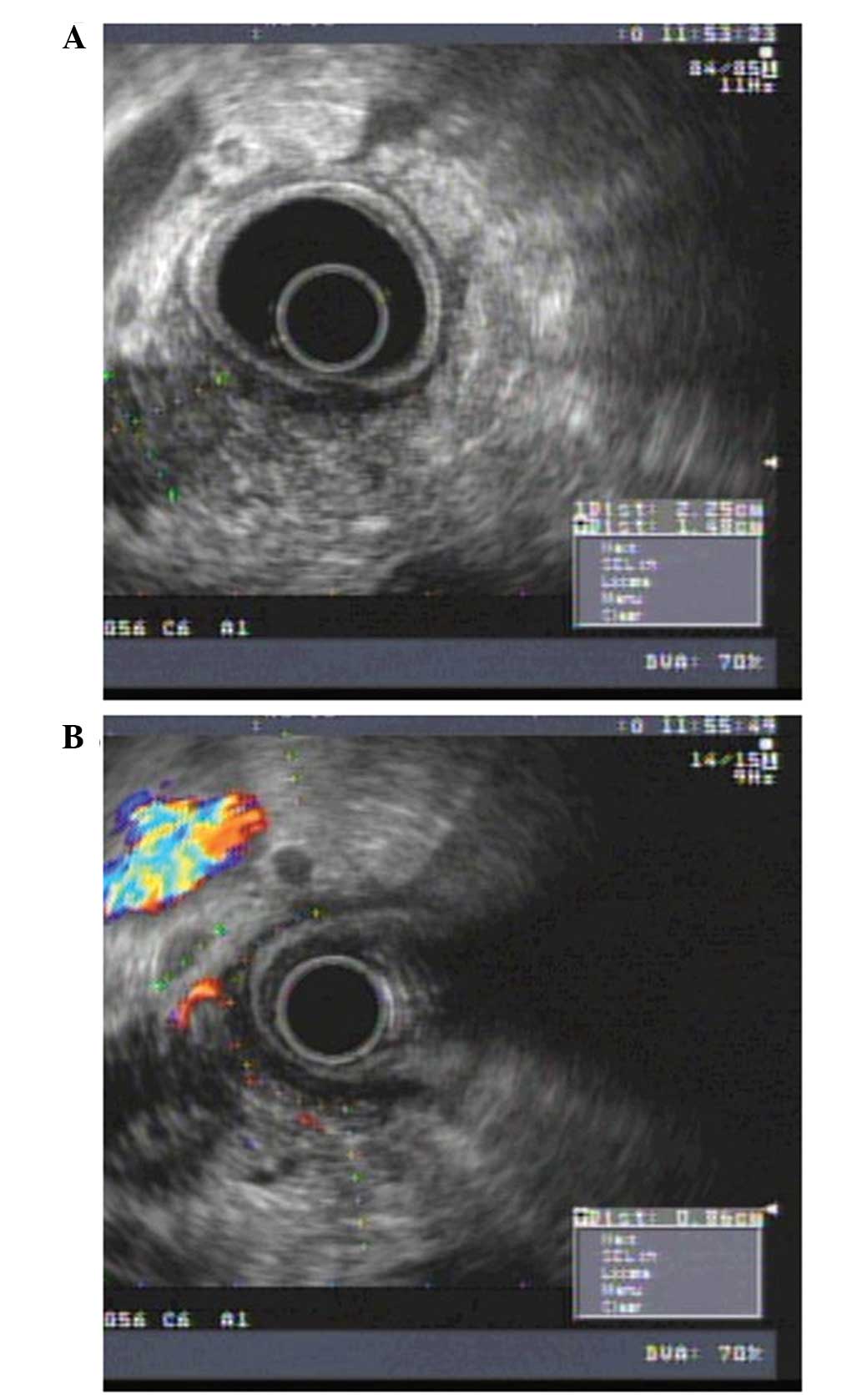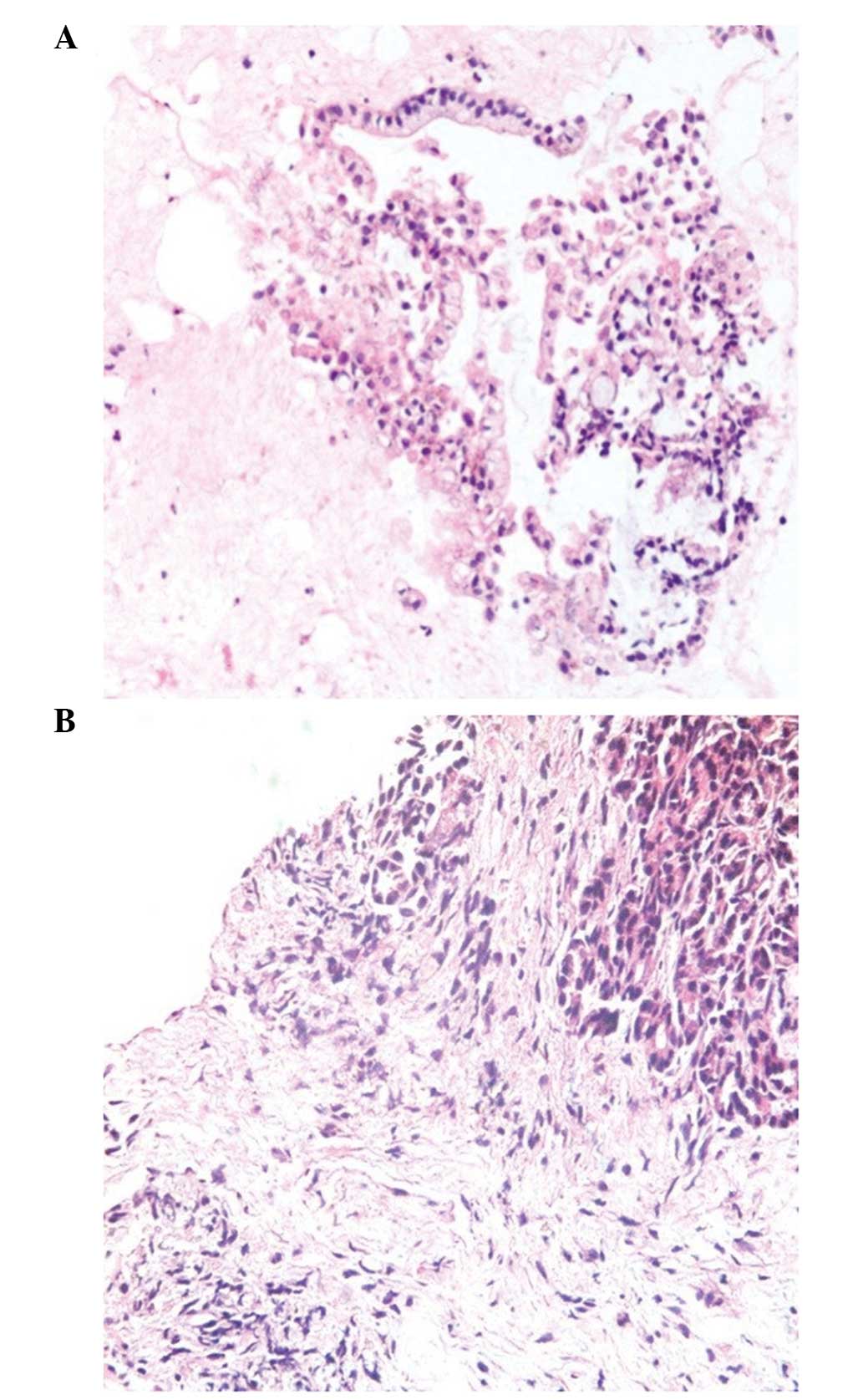|
1
|
Harewood GC and Wiersema MJ:
Endosonography-guided fine needle aspiration biopsy in the
evaluation of pancreatic masses. Am J Gastroenterol. 97:1386–1391.
2002. View Article : Google Scholar : PubMed/NCBI
|
|
2
|
Sengupta S, Pal S, Biswas BK, Chakrabarti
S, Bose K and Jana S: Fine-needle aspiration cytology of
retroperitoneal lesions: A 5-year experience with an emphasis on
cytohistological discrepancy. Acta Cytol. 58:138–144. 2014.
View Article : Google Scholar : PubMed/NCBI
|
|
3
|
Han C, Lin R, Liu J, Hou X, Qian W and
Ding Z: Endoscopic Ultrasonography-Guided Biopsy for
Differentiation of Benign and Malignant Pelvic Lesions: A
Systematic Review and Meta-Analysis. Dig Dis Sci. 60:3771–3781.
2015. View Article : Google Scholar : PubMed/NCBI
|
|
4
|
Vilmann P, Jacobsen GK, Henriksen FW and
Hancke S: Endoscopic ultrasonography with guided fine needle
aspiration biopsy in pancreatic disease. Gastrointest Endosc.
38:172–173. 1992. View Article : Google Scholar : PubMed/NCBI
|
|
5
|
Chen J, Yang R, Lu Y, Xia Y and Zhou H:
Diagnostic accuracy of endoscopic ultrasound-guided fine-needle
aspiration for solid pancreatic lesion: A systematic review. J
Cancer Res Clin Oncol. 138:1433–1441. 2012. View Article : Google Scholar : PubMed/NCBI
|
|
6
|
Cho C, Dewitt J and Al-Haddad M:
Echo-endoscopy: New therapeutic frontiers. Minerva Gastroenterol
Dietol. 57:139–158. 2011.PubMed/NCBI
|
|
7
|
Krishna NB, LaBundy JL, Saripalli S,
Safdar R and Agarwal B: Diagnostic value of EUS-FNA in patients
suspected of having pancreatic cancer with a focal lesion on CT
scan/MRI but without obstructive jaundice. Pancreas. 38:625–630.
2009. View Article : Google Scholar : PubMed/NCBI
|
|
8
|
Eloubeidi MA, Tamhane A, Varadarajulu S
and Wilcox CM: Frequency of major complications after EUS-guided
FNA of solid pancreatic masses: A prospective evaluation.
Gastrointest Endosc. 63:622–629. 2006. View Article : Google Scholar : PubMed/NCBI
|
|
9
|
Beane JD, House MG, Coté GA, DeWitt JM,
Al-Haddad M, LeBlanc JK, McHenry L, Sherman S, Schmidt CM, Zyromski
NJ, et al: Outcomes after preoperative endoscopic ultrasonography
and biopsy in patients undergoing distal pancreatectomy. Surgery.
150:844–853. 2011. View Article : Google Scholar : PubMed/NCBI
|
|
10
|
Zeppa P, Barra E, Napolitano V, Cozzolino
I, Troncone G, Picardi M, De Renzo A, Mainenti PP, Vetrani A and
Palombini L: Impact of endoscopic ultrasound-guided fine needle
aspiration (EUS-FNA) in lymph nodal and mediastinal lesions: A
multicenter experience. Diagn Cytopathol. 39:723–729. 2011.
View Article : Google Scholar : PubMed/NCBI
|
|
11
|
Turner BG, Cizginer S, Agarwal D, Yang J,
Pitman MB and Brugge WR: Diagnosis of pancreatic neoplasia with EUS
and FNA: A report of accuracy. Gastrointest Endosc. 71:91–98. 2010.
View Article : Google Scholar : PubMed/NCBI
|
|
12
|
Maker AV, Katabi N, Gonen M, DeMatteo RP,
D'Angelica MI, Fong Y, Jarnagin WR, Brennan MF and Allen PJ:
Pancreatic cyst fluid and serum mucin levels predict dysplasia in
intraductal papillary mucinous neoplasms of the pancreas. Ann Surg
Oncol. 18:199–206. 2011. View Article : Google Scholar : PubMed/NCBI
|
|
13
|
Nguyen TQ, Kalade A, Prasad S, Desmond P,
Wright G, Hart D, Conron M and Chen RY: Endoscopic ultrasound
guided fine needle aspiration (EUS-FNA) of mediastinal lesions. ANZ
J Surg. 81:75–78. 2011. View Article : Google Scholar : PubMed/NCBI
|
|
14
|
Dubravcsik Z, Serényi P, Madacsy L and
Szepes A: Endoscopic ultrasound-guided fine needle aspiration
cytology in the mediastinum. Orvosi Hetill. 154:338–344. 2013.(In
Hungarian). View Article : Google Scholar
|
|
15
|
Han C, Lin R, Yu J, Zhang Q, Zhang Y, Liu
J, Ding Z and Hou X: A case report of esophageal bronchogenic cyst
and review of the literature with an emphasis on endoscopic
ultrasonography appearance. Medicine (Baltimore). 95:e31112016.
View Article : Google Scholar : PubMed/NCBI
|
|
16
|
Chen G, Liu S, Zhao Y, Dai M and Zhang T:
Diagnostic accuracy of endoscopic ultrasound-guided fine-needle
aspiration for pancreatic cancer: A meta-analysis. Pancreatology.
13:298–304. 2013. View Article : Google Scholar : PubMed/NCBI
|
|
17
|
Puli SR, Bechtold ML, Buxbaum JL and
Eloubeidi MA: How good is endoscopic ultrasound-guided fine-needle
aspiration in diagnosing the correct etiology for a solid
pancreatic mass? A meta-analysis and systematic review. Pancreas.
42:20–26. 2013. View Article : Google Scholar : PubMed/NCBI
|
|
18
|
Puli SR, Batapati Krishna Reddy J,
Bechtold ML, Ibdah JA, Antillon D, Singh S, Olyaee M and Antillon
MR: Endoscopic ultrasound: It's accuracy in evaluating mediastinal
lymphadenopathy? A meta-analysis and systematic review. World J
Gastroenterol. 14:3028–3037. 2008. View Article : Google Scholar : PubMed/NCBI
|
|
19
|
Korenblit J, Anantharama A, Loren DE,
Kowalski TE and Siddiqui AA: The role of endoscopic
ultrasound-guided fine needle aspiration (EUS-FNA) for the
diagnosis of intra-abdominal lymphadenopathy of unknown origin. J
Interv Gastroenterol. 2:172–176. 2012. View Article : Google Scholar : PubMed/NCBI
|
|
20
|
Anderson B, Singh J and Jafri SF: Tumor
seeding following endoscopic ultrasonography-guided fine-needle
aspiration of a celiac lymph node. Dig Endosc. 25:344–345. 2013.
View Article : Google Scholar : PubMed/NCBI
|
|
21
|
Huh JW, Kwon SY, Lee JH and Kim HR:
Comparison of restaging accuracy of repeat FDG-PET/CT with pelvic
MRI after preoperative chemoradiation in patients with rectal
cancer. J Cancer Res Clin Oncol. 141:353–359. 2015. View Article : Google Scholar : PubMed/NCBI
|
|
22
|
Moon JH, Choi HJ and Lee YN: Endoscopic
retrograde cholangiopancreatography. Endoscopy. 46:775–778. 2014.
View Article : Google Scholar : PubMed/NCBI
|
|
23
|
Kedia P, Gaidhane M and Kahaleh M:
Technical advances in endoscopic ultrasound (EUS)-guided tissue
acquisition for pancreatic cancers: How can we get the best results
with EUS-guided fine needle aspiration? Clin Endosc. 46:552–562.
2013. View Article : Google Scholar : PubMed/NCBI
|
|
24
|
Volmar KE, Vollmer RT, Jowell PS, Nelson
RC and Xie HB: Pancreatic FNA in 1000 cases: A comparison of
imaging modalities. Gastrointest Endosc. 61:854–861. 2005.
View Article : Google Scholar : PubMed/NCBI
|
|
25
|
Wilson JL, Kalade A, Prasad S, Cade R,
Thomson B, Banting S, Mackay S, Desmond PV and Chen RY: Diagnosis
of solid pancreatic masses by endoscopic ultrasound-guided
fine-needle aspiration. Intern Med J. 39:32–37. 2009. View Article : Google Scholar : PubMed/NCBI
|
|
26
|
Yoshinaga S, Suzuki H, Oda I and Saito Y:
Role of endoscopic ultrasound-guided fine needle aspiration
(EUS-FNA) for diagnosis of solid pancreatic masses. Dig Endosc.
23(Suppl 1): 29–33. 2011. View Article : Google Scholar : PubMed/NCBI
|
|
27
|
LeBlanc JK, Ciaccia D, Al-Assi MT, McGrath
K, Imperiale T, Tao LC, Vallery S, DeWitt J, Sherman S and Collins
E: Optimal number of EUS-guided fine needle passes needed to obtain
a correct diagnosis. Gastrointest Endosc. 59:475–481. 2004.
View Article : Google Scholar : PubMed/NCBI
|
|
28
|
Fusaroli P, Spada A, Mancino MG and
Caletti G: Contrast harmonic echo-endoscopic ultrasound improves
accuracy in diagnosis of solid pancreatic masses. Clin
Gastroenterol Hepatol. 8:629–634, e622. 2010. View Article : Google Scholar : PubMed/NCBI
|
|
29
|
Napoleon B, Alvarez-Sanchez MV, Gincoul R,
Pujol B, Lefort C, Lepilliez V, Labadie M, Souquet J, Queneau PE,
Scoazec JY, et al: Contrast-enhanced harmonic endoscopic ultrasound
in solid lesions of the pancreas: Results of a pilot study.
Endoscopy. 42:564–570. 2010. View Article : Google Scholar : PubMed/NCBI
|
|
30
|
Sun B, Yang X, Ping B, He Y and Zhang Z:
Impact of inconclusive endoscopic ultrasound-guided fine-needle
aspiration results in the management and outcome of patients with
solid pancreatic masses. Dig Endosc. 27:130–136. 2015. View Article : Google Scholar : PubMed/NCBI
|
|
31
|
Maleki Z, Erozan Y, Geddes S and Li QK:
Endorectal ultrasound-guided fine-needle aspiration: A useful
diagnostic tool for perirectal and intraluminal lesions. Acta
Cytol. 57:9–18. 2013. View Article : Google Scholar : PubMed/NCBI
|
|
32
|
Iglesias-Garcia J, Dominguez-Munoz JE,
Abdulkader I, Larino-Noia J, Eugenyeva E, Lozano-Leon A and
Forteza-Vila J: Influence of on-site cytopathology evaluation on
the diagnostic accuracy of endoscopic ultrasound-guided fine needle
aspiration (EUS-FNA) of solid pancreatic masses. Am J
Gastroenterol. 106:1705–1710. 2011. View Article : Google Scholar : PubMed/NCBI
|
|
33
|
Alsohaibani F, Girgis S and Sandha GS:
Does onsite cytotechnology evaluation improve the accuracy of
endoscopic ultrasound-guided fine-needle aspiration biopsy? Can J
Gastroenterol. 23:26–30. 2009. View Article : Google Scholar : PubMed/NCBI
|
|
34
|
Campisi P, Accinelli G, De Angelis C,
Pacchioni D and Bussolati G: On-site evaluation and triage for
endoscopic ultrasound-guided fine needle aspiration cytology. The
Turin experience. Minerva Med. 98:395–400. 2007.(In Italian).
PubMed/NCBI
|
|
35
|
Al-Haddad M and Eloubeidi MA:
Interventional EUS for the diagnosis and treatment of locally
advanced pancreatic cancer. JOP. 11:1–7. 2010.PubMed/NCBI
|
|
36
|
Widmer JL and Michel K: Endoscopic
ultrasound-guided treatment beyond drainage: Hemostasis,
anastomosis and others. Clin Endosc. 47:432–439. 2014. View Article : Google Scholar : PubMed/NCBI
|
|
37
|
Fisher L, Segarajasingam DS, Stewart C,
Deboer WB and Yusoff IF: Endoscopic ultrasound guided fine needle
aspiration of solid pancreatic lesions: Performance and outcomes. J
Gastroenterol Hepatol. 24:90–96. 2009. View Article : Google Scholar : PubMed/NCBI
|
|
38
|
Möller K, Papanikolaou IS, Toermer T,
Delicha EM, Sarbia M, Schenck U, Koch M, Al-Abadi H, Meining A,
Schmidt H, et al: EUS-guided FNA of solid pancreatic masses: High
yield of 2 passes with combined histologic-cytologic analysis.
Gastrointest Endosc. 70:60–69. 2009. View Article : Google Scholar : PubMed/NCBI
|
|
39
|
Hwang CY, Lee SS, Song TJ, Moon SH, Lee D,
Park DH, Seo DW, Lee SK and Kim MH: Endoscopic ultrasound guided
fine needle aspiration biopsy in diagnosis of pancreatic and
peripancreatic lesions: A single center experience in Korea. Gut
Liver. 3:116–121. 2009. View Article : Google Scholar : PubMed/NCBI
|
















